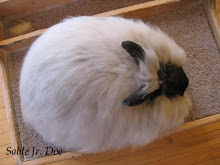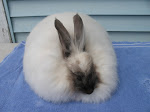---This is another post from the old blog. Sorry about all the older posts lately, but December is a busy month and I do want to get all the old posts transferred so that they will be readily available in the archives. Have a great week and stay warm!:-).
The best way to know what your rabbits carry genetically is by looking at what they produce in the nestbox. Of course, it is a great help to know what colors the parents were because alot can be ascertained that way, but breeding a rabbit several times and recording the colors that result can make it much easier to formulate a genotype for the sire and dam.
The basic rule of genetics is that a rabbit can only pass on what it carries or expresses to it's offspring, and since each offspring inherits half of each pair of genes from it's dam and the other half from it's sire, the colors that result will depend on how those genes interact with each other.
Some genes are dominant, which means that they will always express themselves first if the other half of the gene pair is recessive. In order to express itself (be visible in the nestbox) a recessive gene has to be paired with another recessive gene. If a certain recessive is always paired with a dominant gene in a particular herd it may never have the chance to express itself, which is why some colors can 'hide' themselves for many, many generations before finding like recessives to pair with and reproduce themselves.
A good example to use in describing how genes get passed on is the color White (or REW). White in rabbits is represented by a lower case 'c', and it takes 2 lower case 'c's to make a white rabbit in a litter. Since 'c' is a purely recessive gene, it is entirely possible for a Colored rabbit (such as a Chestnut or Self, for ex.) to be carrying it with no surface evidence whatsoever. If you were to breed that 'c' carrying rabbit to another rabbit though (White or Colored) that also carried a recessive 'c', then the result will be at least a few REW babies in the nestbox. There is a great deal of White in the majority of the Angora breeds because REW is a very competitive color in Angoras, but some non-wool breeds consider the gene a serious liability because White is not a recognized color in every type of rabbit.
If two colored parents are bred and REW babies appear in the litter (even just one), then you can be 100% certain that both parents carry the 'c' gene. Similarly, if both parents are Selfs (or one is even a REW) but you get one of the 'ee' colors in the nestbox (that would be Fawn, Red, Cream, Pearl, Tort, or Ermine) then you know that each parent must carry a recessive 'e', and so on.
To determine what color a REW really is under the white 'sheet' (because there is always a different, 'real' color in those rabbits), the best thing to do is breed it to a Self and examine what comes up in the litter. If you find Agouti babies in a nestbox out of a Self/REW breeding then you can be certain that the REW parent must be an Agouti under the White because the Agouti gene is dominant and could never have come from a Self (which is recessive too). Conversely, if you get nothing but Selfs in a good sized litter then you can be fairly certain that the REW must be Self underneath too, and you can use that information in future breedings to produce fewer unrecognized colors.
Why is it important to know what a REW is underneath in the first place? Well, the worst color combination that can be performed in rabbits is usually the Agouti/Shaded combination. Babies out of these pairings will often be a complete mishmash of color and can be so jumbled phenotypically that they cannot even be identified. They can never be shown, registered, or even sold very often because the majority of breeders will not accept unrecognized varieties into their gene pools. Even if they could be sold as pets or woolers there is always the chance that someone will take it upon themselves to experiment and breed 2 rabbits together just to 'see what happens' and end up producing an even larger cache of unrecognized colors that are unshowable, unregisterable, and unsellable.
Testing a REW first to know what color truly lies beneath the blanket allows you to use that rabbit according to it's real color in future breedings. If a White rabbit is genetically an Agouti, then you know that you can use this rabbit only with other Agoutis or Selfs, and should never use it with a Shaded. If your REW is genetically a Self then you have greater flexibility and can use it with other groups without fear of strange colors turning up. Combining 2 REWs can ONLY result in an all-White litter so you would not know what either parent carried in that case, but since REWs cannot carry Shaded genes (the 'c' being completely recessive) you would not be adding those genes to your pot to begin with.
Note: Breeders of other breeds are often mortified at the rate at which Angora breeders mix colors, and IMO they have a very legitimate point. The best and truest color comes from breeding pairs of the same variety together over several consecutive generations, and we in the Angora world would do well to imitate that policy if we want to weed out most of the color issues that plague our breed. Since wool animals are often raised by spinners as well as showpeople the desire for variety in color is strong, but the best way to achieve both variety and quality is to focus on each color separately and improve it slowly over time.
Sunday, December 13, 2009
Subscribe to:
Post Comments (Atom)























2 comments:
Why this is my kind of blog!
So glad I found your blog - a few years ago, I was in 4-H and bred/showed Dwarf Hotots. But, my parents divorced and at the time I was under 18 so had no say in keeping my rabbits. I'd like to get back into it one day when I'm out of college. In the meantime, I really enjoy reading about your rabbits!
Post a Comment